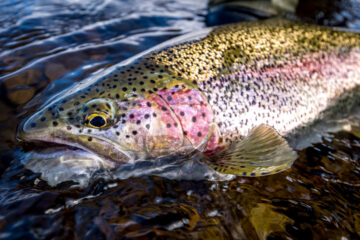By the time Europeans made it to Alaska in the mid-1700s, fly fishing was already an ancient sport. Flip the calendar forward about 100 years, and folks on the Continent considered it a pastime for the elite. Yes, while Alaskans were fly fishing to put food on the table, casting became an art form back in Europe. That’s not really bad when you think about it. All those lucky people with time on their hands came up with some impressive innovations that we take for granted today. Let’s start at the beginning.
Everybody Was Fly Fishing
It was a just another lazy afternoon in the 2nd century when Roman teacher Claudius Aelianus settled in to watch anglers casting into the Astraeus River. He was so impressed with their tackle and technique that he put stylus to tablet describing round hooks wrapped in red wool and sporting cock feathers. He sang the praises of perfectly placed casts from 6-foot poles, but the Romans didn’t have a monopoly on anything. The Japanese had been at it for centuries too, and fly fishing eventually migrated to Europe and England where it found no boundaries in age or gender.
If you don’t think of women as accomplished anglers, you need to get out more. The very first book of instruction on fly fishing was written by Englishwoman Juliana Berners in 1496. Her publication was a how-to that covered rods, line, hook making and fly tying. You have to wait until the 1600s for someone to actually use the term “cast a fly.” That credit goes to Shakespeare’s fishing buddy, John Dennys, who was moved to write poetry about the sport. By then, what had started out as a necessity for filling pantries had become a favorite pastime.
Mass Production Actually Helped
No one documented early fly fishing in Alaska, but it’s a safe bet that the first rigs were homemade. Settling this wild territory took steel will and sharp wits, so there’s no doubt that our original anglers made their own gear. It took the Industrial Revolution and mass production to make tackle available for frustrated fishermen who were tired of twisting their own line. Running rings and pre-fab flies were considered fancy innovations, debating the pros and cons of wet versus dry became a sport of its own, and fly fishing books sailed off printing presses.
The next time you drop by the Anchorage Public Library, check out a copy of “The Fly-Fisher’s Entomology.” Alfred Ronalds published this definitive volume back in 1836, but it might look familiar because it set the standard for today’s fly-fishing literature. You won’t find a better collection of angler’s eye candy. The book is beautifully illustrated with full-color plates showcasing fish and flies. Reading about the history of fly fishing in Alaska is fun, but this visual journey into the sport’s past is as inspiring as it is glorious.
It Just Kept Getting Better
Two very important things happened to Alaskan fly fishing in the 1950s. The first was as simple as synthetics, and these modern marvels made our fishing lives easier. Fiberglass rods filled sporting goods stores with affordable poles that were durable and easy to handle. Synthetic fly lines spilled out of tackle boxes, and leaders became almost magical with monofilament. It’s hard to believe that those glass rods are considered antiques now, but many anglers still prefer them over today’s faster graphites.
The second very important thing was much more official. We finally achieved statehood in 1959. Folks in the Lower 48 had always known that Alaska was a premier destination for outdoor adventures, but all that publicity helped spread the good word about the incredible fly fishing up here. Our natural hospitality opened the doors on fishing lodges all across the state, and more than 3,000 of the world’s most beautiful rivers still enchant anglers today just like they charmed those original fly fisherman 250 years ago.
You can read all about our state’s rich history, but Alaskan fly fishing deserves special respect. The tall tales and fish stories that make dinner at our Main Lodge so entertaining never make it to a printed page, but that’s OK. Every adventure here at No See Um Lodge lives many lifetimes as memories passed on from one generation to the next. If you’ve been here before, you understand. If not, we cordially invite you to visit our wonderful home and become a part of the history we’ve been making up here on the Kvichak River for more than 40 years.
